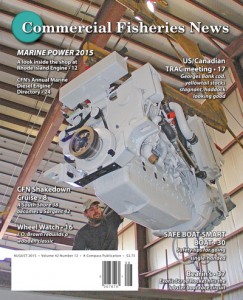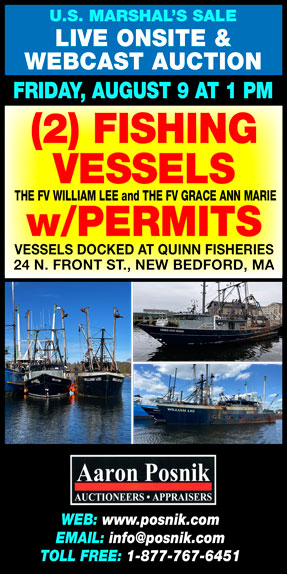Less than two weeks ago, a good friend that’s an inshore lobsterman called me and said “I don’t seem to be able to find or keep a crewman, so I’m going single-handed. What would you recommend for safety equipment?”
I recommended a Mustang Elite auto-inflate lightweight PFD and a PLB (Personal Location Beacon) with built-in GPS.
Gladly, he took the initiative and purchased this exact safety equipment.
However, for days after my mind was racing with thoughts. We need to assess his risk and formulate a plan to address a major incident and survive.

A qualified Coast Guard-approved marine drill instructor, Fred Mattera of Point Judith, RI is the owner/president of North East Safety Training Co. (NESTCo), which conducts fishing vessel drills and inspections and basic safety training workshops.
A commercial fisherman for 40 years, Mattera is a member of the Commercial Fishing Safety Advisory Committee to the Coast Guard, and, since 1998, has been president of the Point Club, a fishing vessel mutual insurance group. He also has served on the board of directors for Sunderland Marine Mutual Insurance Co., the principal underwriter for the Point Club and more than 2,000 US fishing vessels, since 1998.
We needed to devise and articulate a Monthly Solo Operator Drills protocol.
His response was, “Fred, I just fish by myself. Why do I have to do emergency drills? No one else is even on the vessel.”
The simple answer: In fact, solo operators of fishing vessels have even more reasons to do their own emergency drills.
Unlike vessels with crews, when you go single-handed there is only one person available to fight a fire, stop flooding, make a Mayday call, and/or rescue yourself from the water. That’s you.
Solo operators will be better prepared by pre-planning and pre-staging their safety and survival equipment and by practicing how to do the many-needed onboard crisis tasks by themselves.
SOLO MAN OVERBOARD DRILL:
Man overboard events on solo-operated vessels often end up as casualties.
So it is especially important for solo-operators to practice self-recovery.
• Have something you can grab from the water to help you climb onboard by yourself. Try boarding your vessel at the dock or mooring – this will help in creating creative ways for self-rescue that work for your vessel. Consider mounting a permanent ladder where it doesn’t interfere with your gear, or mount a line over the rail within reach of the water that will release a rope ladder when tugged, (Plano makes these ladders).
• Have a knife in a sheath on your person and place another strategically down the rails to the stern.
• We never expect to go overboard until that split second before falling. Then it’s too late to put on a PFD, so wear your PFD at all times. Try on and inspect numerous types of PFD’s that are suitable for your working conditions. I prefer auto-inflate in case you hit your head; the Hammer auto-inflate models are activated in 4” of water. Check your PFD monthly for excessive wear-and-tear and partially top off the bladder with the mouth inflator for possible leaks.
• Consider buying an electronic MOB device that will shut off your engine once you enter the water. This will provide an opportunity to catch up to your vessel. Do monthly checks to operate and deploy the MOB device.
• Review how you would recover a crewman from another vessel who is a MOB victim. Practice throwing the life ring and using a life sling for retrieval, and master the skill of how to hoist a victim onboard.
SOLO FLOODING DRILL:
Reviewing your gear and procedures will greatly aid in a flooding emergency.
• Check the seals, gaskets, and dogs on watertight doors and hatches.
• Check all underwater hoses and plumbing for leaks, and have double hose clamps.
• Check that the seacock is functioning properly.
• Check that bilge pumps are functioning properly.
• Check that all high water alarms are functioning and that all suctions and strainers function.
• Assemble a flood kit – including wooden wedges, cone plugs, hatchet (trimming and hammering) flashlight, screwdrivers, hose clamps, duct tape, bicycle innertubes cut and split, wire ties, dive gloves, knife, etc.
SOLO FIRE DRILL:
A fire drill by the solo operator can be more of a hands-on practice.
• Review location of fire extinguishers and their use (PASS: P, pull pin; A, Aim; S, Squeeze; and S, Sweep).
• Operate fuel shut-offs, electrical panel shut-offs, and PTO shutoffs (find them in the dark), and be sure all gauges are in the charge mode.
• Look for sources and locations of potential fires, including: hydraulics and hoses; dry exhaust (create a window to view condition of exhaust wrap and the plywood for charcoaling); main engine; fuel racks and fuel lines leaking; frayed or chafed wiring; plus battery connections and electrical panel.
• Do a “boundary check” for any safety equipment (that is beyond reach or has been removed) or any flammable material that should be moved.
• Locate vents and practice securing them with non-flammable material (foulweather gear works well).
• If you have smoke and fire alarms onboard, do a test.
• Most importantly, be sure that your immersion suit is in the pilothouse and readily available and, if your EPIRB is mounted on the cabintop, consider moving it to the back outside wall of the pilothouse for quick access.
• Review procedures for fighting a fire, including making a 1-2 minute Mayday call (if time permits), before attacking the fire. My theory is that your life is most important – we can replace the boat; we can’t replace you.
SOLO ABANDON SHIP DRILL:
• Mayday call. Practice saying repeatedly the five critical parts of a Mayday: Name, Position, Nature of Distress, and POB (People Onboard and Vessel Description)
• EPIRB. Take the EPIRB out of its shell, test it monthly and know how to manually activate it. Make sure battery hasn’t expired and the hydro-release mechanism is current. It is most importantly that your NOAA decal date is current and the UIN number matches the UIN number on the EPIRB unit.
• Flares. Know their location and check their expiration dates, plus review and practice activating all flares.
• Immersion suit. Be sure your immersion suit is readily available and practice donning the suit in 60 seconds or less. Inspect the suit for tears or open seams, keep zippers waxed and strobe lights functioning.
• Life raft. Review your life raft launch procedure, be sure the hydro-release mechanism is current and the painter is shackled into the red square weaklink. Make sure quick-release and or pelican hook function properly.
• Ditch kit. Consider packing a ditch kit that is readily available in the pilothouse with extra water, energy bars, flashlight, medication if needed, matches, twine, duct tape, knife, plastic bags, handheld VHF, etc.).
• Secure the vessel. Remember to close all doors and hatches upon leaving the vessel.
By performing these various drills, the solo operator may often find that reconfiguring the placement of safety equipment for ease of access makes sense. You don’t know this until you have run the drill a few times.
Finally, keep in mind that the solo operator faces many unique challenges in an emergency at sea.
Obviously, with no other crew to share duties with, it is even more important for you as a solo operator to practice and be prepared.

To read the rest of the August issue of Commercial Fisheries News – please choose from the following options:
Buy a Single PRINT edition of CFN that is delivered by MAIL. PRINT EDITION
Quickly enjoy ONLINE access with our flip-book. ONLINE EDITION
(Read online flip-book immediately with access key and download a copy for yourself. Not sure? SAMPLE HERE)
SAVE BIG when you SUBSCRIBE!








 Updating...
Updating...